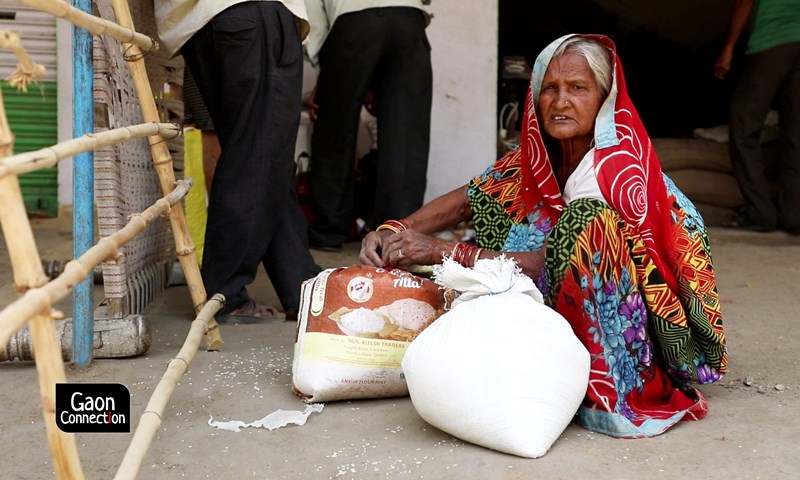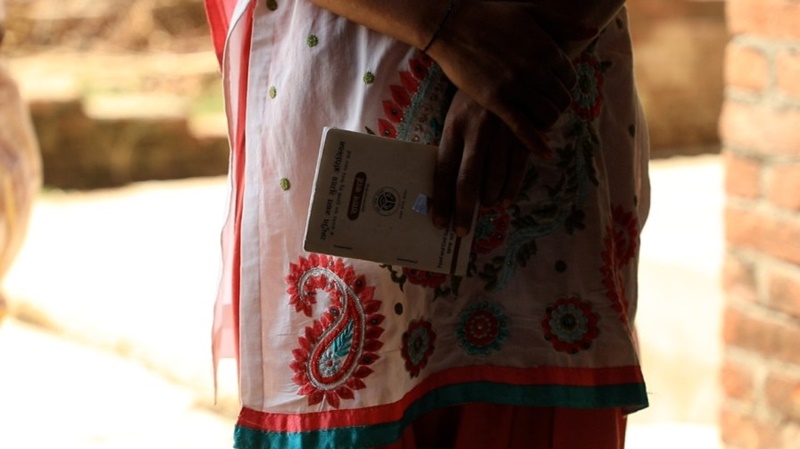The Centre’s free ration scheme explained; extended till November this year
The Central government will grant each eligible person five additional kilogrammes of free ration till November this year. This is expected to provide big relief to those whose incomes have been hit hard by the COVID19 pandemic.


The Antyodaya card beneficiary family receives a ration of 35 kilogrammes, irrespective of the number of family members. All photos: Gaon Connection
Amid the pall of gloom brought on by the COVID19 pandemic, there’s some news that could provide relief to ration cardholders. Eligible cardholders (Antyodaya and other families that qualify) under the National Food Security Act would receive five additional kilogrammes of free food grains per family member until November this year under the Pradhan Mantri Garib Kalyan Yojana or PMGKY.
The fourth phase of the Pradhan Mantri Garib Kalyan Yojana (Free Ration Card 2021) was approved on June 23 during the Union Cabinet meeting led by Narendra Modi. The Pradhan Mantri Garib Kalyan Yojana ration is distinct from what is given under the National Food Security Act (NFSA) ration, and is free.
The National Food Security Act 2013 provides ration under two different systems.
Eligible household ration cardholder:
This cardholder receives five kilogrammes of ration for each family member. The cardholder can choose to take either rice or wheat or both. Ration cardholders pay Rs three per kilogramme of rice and Rs two per kilogramme of wheat to the fair price shop dealer.
Antyodaya Card Holder:
The beneficiary family receives a ration of 35 kilogrammes, irrespective of the number of family members. Under the Antyodaya Anna Yojana, wheat costs Rs two per kilogramme, while rice costs Rs three. For example, in Uttar Pradesh, an Antyodaya card user can obtain 15 kilogrammes of rice (Rs 45) and 20 kg of wheat (Rs 40) for Rs 85, whereas, in Rajasthan, it is only wheat that is available for Rs 35, that is one rupee per kilogramme.
Also Read: Rajiv Singh Yadav, a ration shop kotedaar, defies the ‘bad guy’ stereotype

Additional five kg of ration
Under the new system, both types of ration card users will get an additional five kilogrammes of ration per family member until November this year. “If a household has four eligible members, they usually receive a ration of twenty kilos. Now, they will get forty kilos, an addition of twenty kilos at no additional cost,” Jyoti Kakwani, District Logistics Officer of Rajasthan’s Udaipur district told Gaon Connection.
However, the price for wheat and rice will be at the discretion of the state government, Kakwani added.
Discretion of the state
For example, in Uttar Pradesh, no money will be charged for three months. However, in Rajasthan, where only wheat is available, eligible households will receive wheat at Rs two a kilogramme, while those with Antyodaya will receive wheat at Rs one1 per kilogramme. “The state government determines the price of ration that the fair price shop dealer charges under the NFSA. The state can choose to make it completely free or lower the selling price,” Kakwani explained.
Also Read: ‘Rice and wheat in India are lot less nutritious than they were 50 years ago’
Free ration in Uttar Pradesh
According to the Uttar Pradesh Food and Logistics Department website, ration benefits are being extended to 148.2 million beneficiaries through 36 million cardholders in the state. “Ration is being provided to around 150 million people in Uttar Pradesh during the Corona crisis. The government has also made wheat [priced at 2 a kilo] and rice [priced at Rs 3 a kilo] free for June, July, and August this year. Three kilos of sugar would also be given to Antyodaya cardholders this month at eighteen rupees a kilogramme,” Anil Kumar Dubey, Additional Food Commissioner in the Department of Food and Logistics, Uttar Pradesh, told Gaon Connection.
“The free ration will be of great benefit to the people. The Corona crisis has had an impact on many industries and livelihoods. The least we can do is provide people with food grains so that they don’t have to risk their lives looking for food,” added Dubey.

Demand to broaden ration scheme
Nikhil Dey, a Right to Food activist and founding member of Mazdoor Kisan Shakti Sangathan, applauded the move to distribute free rations until November but emphasised the need to broaden its coverage.
Also Read: 4 months, 4 sheep and an income of Rs 8
“Free ration has saved many lives during the COVID crisis. Owing to Corona and the lockdown, an important group earning between ten and twelve thousand rupees a month is now earning substantially less. People under this category have lost a lot and they don’t have ration cards, but urgently require food security.” Dey said.
“This year, we did not see them on the roads because all modes of transportation were operational, but their economic situation is dire, and they are struggling to make ends meet,” Dey added.
The activist also requested that the National Food Security Act broaden the scope of who is a ration cardholder. “Under the social security scheme, 400,000 poor households in Rajasthan receive pension. They do not, however, receive ration. Likewise, 800,000 senior citizens get pension under the social security plan, but do not have a card, even though they are self-sufficient,” he pointed out.
Dey wants the government to distribute the 100 million tonnes of foodgrains in stock fairly among everyone at Rs five a kilogramme, instead of letting them rot in warehouses.

Where is the dal?
Last year, dal (pulses) was provided as part of the free ration card scheme, but this year, no dal was given in May or June. “Roti and rice are insufficient to fill stomachs. Dal and oil should be provided,” said Dey.
In his June 7 address this year, Prime Minister Narendra Modi discussed extending ration distribution until November 2021. “The government is on the side of the poor during this crisis,” he said.
The extension till November is expected to benefit around 815 million people. Around 20.4 million metric tonnes of food grains are scheduled to be provided during this period. This is expected to result in a food subsidy demand of around Rs 640.31 billion. The Central Government is footing the bill for this scheme. It will also spend an additional Rs 32.34 billion on transportation and handling, as well as fair price shop dealer margins, among other things.

